You need to know the time value of notes and also the key if you want to play the song properly, or if you want to communicate what you’re doing to other musicians. The simple answer is as follows:
The difference between a key signature and a time signature is that a key signature indicates the order of sharps and flats in a piece of music, and a time signature tells you how many beats are in each measure as well as what note gets 1 full beat.
The Primary Differences Between A Key Signature and A Time Signature
1) Key Signatures Use Sharps and Flats to Identify the Key – Time Signatures Explain Time Values
As I discussed in my other guide on keys, sharps, and flats, accidentals (also known as sharps and flats) are used at the beginning of, or sometimes in the middle of, a piece of music to identify the key.
The amount of sharps or flats represented in the piece of music gives the musician an understanding of the tonal possibilities of the piece. But more importantly, what the key signature does is that it saves the composer a lot of time adding accidentals to every single note in the sheet music.

For instance, having to write a “flat” symbol beside every B, E, and A note in the key of E-flat major like what’s shown above would take far too much time.

2) Time Signatures Measure the Number of Beats Per Measure And What Note Gets 1 Beat
The numbers after the key signature may look very similar to what a fraction in mathematics looks like. If your teacher ever told you that music was just mathematics, they were right, because we use math and patterns all over the place in music.
This visual example may help you understand how to determine the time signature. In simple terms, a time signature divides measures and bars of music into increments. They give a time structure to an otherwise abstract concept. With a time signature, we can accurately divide a bar of music into increments of time.
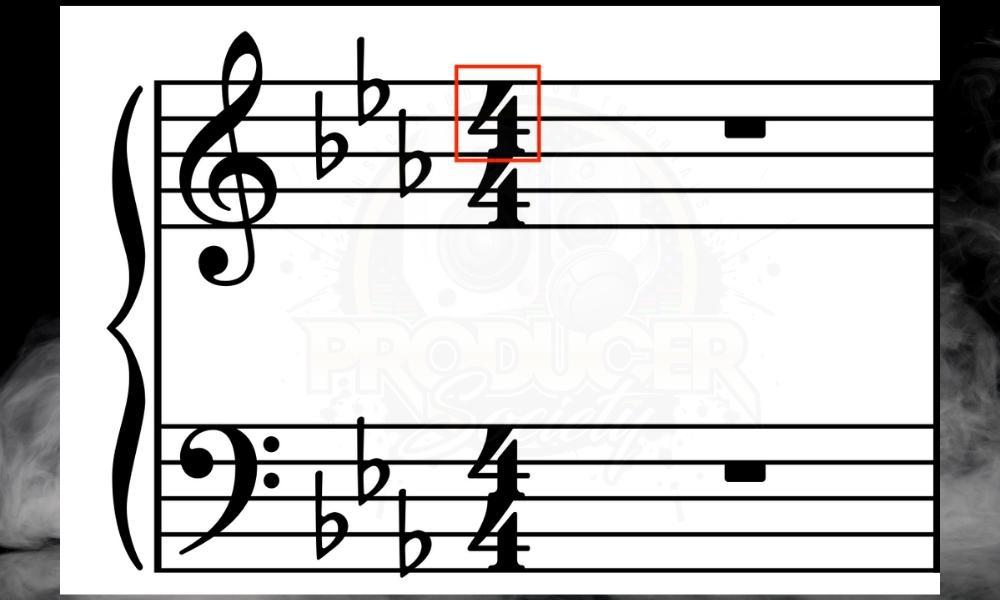
The bottom number shows the note value of those beats. For instance, a “4” on the bottom of the time signature tells us that a 1/4-note gets one beat. The 4 on the top tells us there are 4 beats in a measure. Therefore, there are 4 beats in a measure and a 1/4 note gets one beat, so there are 4 quarter-notes per measure.
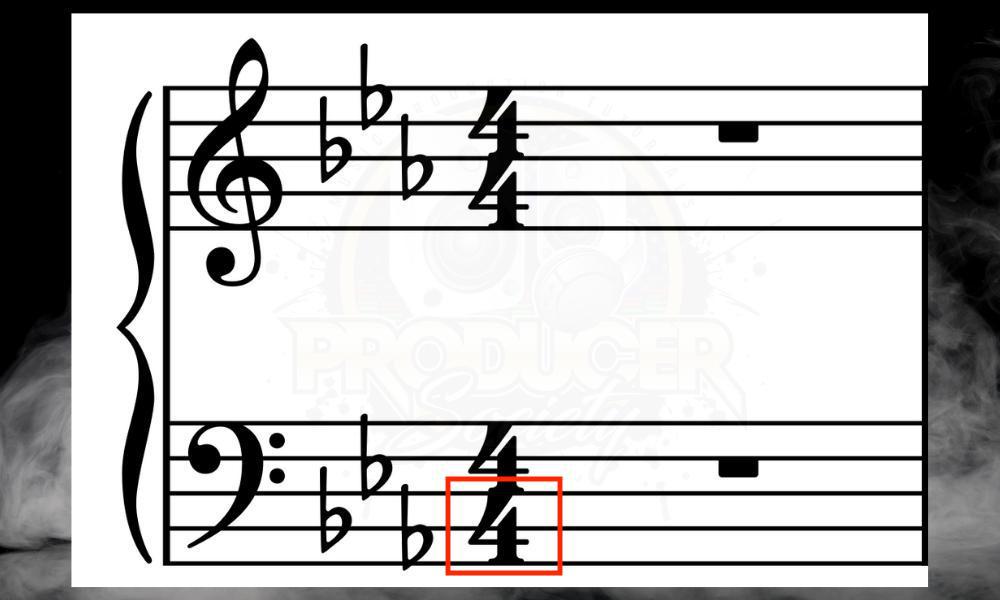
Other Differences Between Key Signatures and Time Signatures
1) Key Signature Comes Before the Time Signature
The music’s key signature comes after the clef but before the time signature. And this is always the case, regardless of context, musical genre, when the composer wrote the piece or any other factor that you can think of.
Notice that if a piece of music has no sharps or flats, it still has a key signature. A piece of music will have a key signature and a time signature every single time.
The example demonstrated down below shows a clef, a key signature, and a time signature. The key signature still exists even if there are no sharps or flats.
Something I first learned from Mark Sarnecki’s Complete Elementary Rudiments (on Amazon – including the Answer Book) is that if there are no sharps or flats, this means we’re either in the Key of C Major, or we’re in the key of A Minor. A Minor is the relative minor of C Major.
![Mark Sarnecki's Complete Elementary Rudiments - Why Do Some Pianos Start With A C and Not an A [ANSWERED]](https://producersociety.com/wp-content/uploads/2022/03/Mark-Sarneckis-Complete-Elementary-Rudiments-Why-Do-Some-Pianos-Start-With-A-C-and-Not-an-A-ANSWERED-1.jpg)
It just means that if you rearrange the notes of C so you start on A, you get a minor sound using the exact same notes. You could also call this the Aeolian mode (more on the modes in my guide).
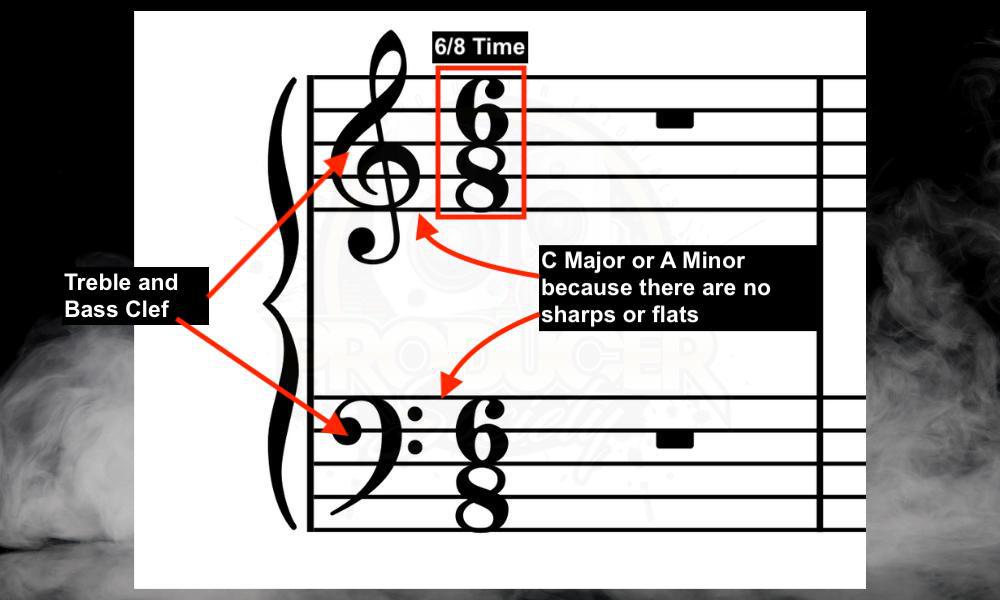
2) Key Signatures Use Sharps and Flats Instead of Numbers like Time Signatures
In music, notes are given names based on their pitch. Those notes are visually recognizable through accidentals like sharps (#) or flats (b).
When a piece of music is in a certain key, the key signature in the piece of music tells you what notes are either sharp or flat for that designated piece of music.
This staff below tells the musician that there is a key signature of three flats. This means that in this piece of music, any time a B, E, or A is played, it should be Bb, Eb, or Ab. And like I said a moment ago, there is a relative minor, so this could also be the key of C Minor.
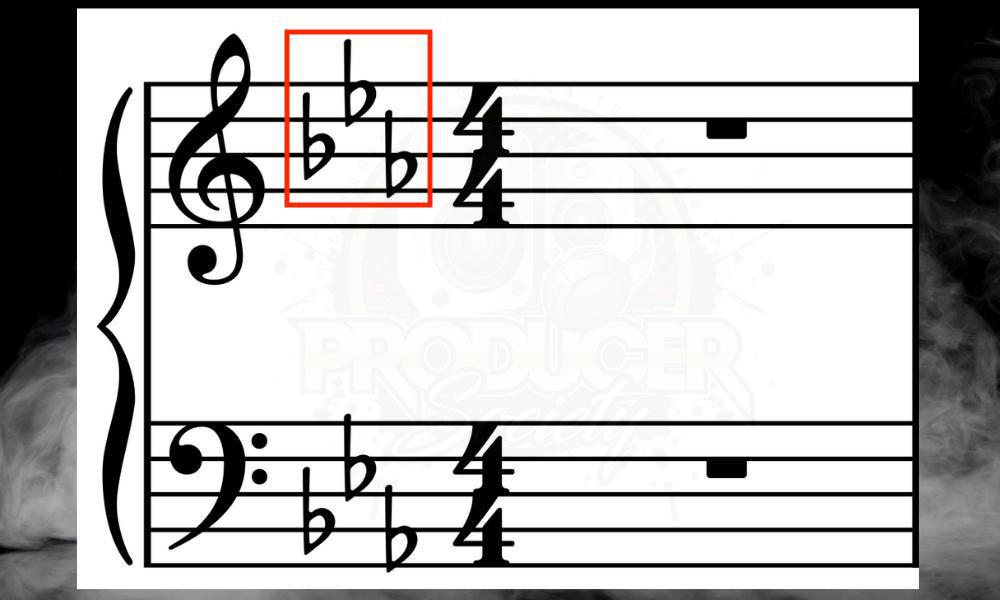
How to Recognize What the Time Signatures Mean
The way to understand time signatures was mentioned earlier by trying to view the time signature as a number of beats over a time value of the note that’s given.
If a piece of music has a 6/8 time signature, that lets the one reading the music know that there is a limit of 6 eighth notes per measure.

If a piece of music has a 3/4 time signature, that lets the one reading the music know that there is a limit of 3 quarter notes per measure.
Of course, these time values can then be divided up into smaller units of time like 16th notes, 32nd notes, 64th notes, etc. You could also use 1/4 notes as well, but these would be expanding on the unit of time, rather than dividing it.

How to Tell the Difference Between Key Signatures
Something I learned from the Punkademic Music Theory Comprehensive Complete course (with their All-Access Pass) is a trick for discovering what key you’re in. To help identify the key quickly to help at the beginning stages, you just have to use your counting skills as well as your understanding of the notes of the staff.
- For any sharp key signature, take the last sharp and move it up a half step in your mind. The note you land on is the major key to that piece of music.

So now we know the note we reference is E# (F). Move that up a half step. F sharp (#) is your key signature. Now you can memorize that six sharps is the key of F#. There is a similar principle for the flats as well, although, you actually count backward instead of forwards. I’ll show you what I mean in a second.
- For any flat key signature, recognize the second to last flat you see and that is your major key signature for that piece of music.

The second to last flat is Db. So we know this key signature is D flat major. Now you can memorize that five flats is the key to D flat major. I use this trick over and over to figure out what key I’m in because I don’t use sheet music all that much as a guitarist.
I just use the tablature in the almighty Guitar Pro application which I got from Plugin Fox. That said, the more you practice, the quicker you will get at recognizing key signatures. Eventually, you will be able to say that four flats are Ab major, one sharp is G major, and one flat is D minor.
With every major key, there is a relative minor key. At this point, I’m pretty good at visualizing how the keys look on the staff. And when I use these patterns and memory tricks, I do visualize what the key signature looks like on the staff.
A) How to Understand Relative Major and Minor Key Signatures
Think of relative major and minor like a family. These key signatures may have different names, but their structure and foundation are really similar. Take a major key like a G major. G major has one sharp as its key signature.

Simply put, a relative minor key is just the 6th note of the corresponding major scale. For example, if you start on G and count up the scale until the 6th note, you get E. If you’re starting on the relative minor, count up the scale by three, starting on E as 1. This gives you G.
This means that the minor key has one sharp as its key signature as well. That minor key is E minor. To tell the difference between the two, the music usually starts or ends with the root note of the key. Depending on which note you start and finish on, you get a different sound. These are called modes which I briefly mentioned earlier.
In other words, you can analyze or play through the piece to determine what the key is based on tonality. For further reference on relative major and minor keys, use the Circle of Fifths which is pictured below:
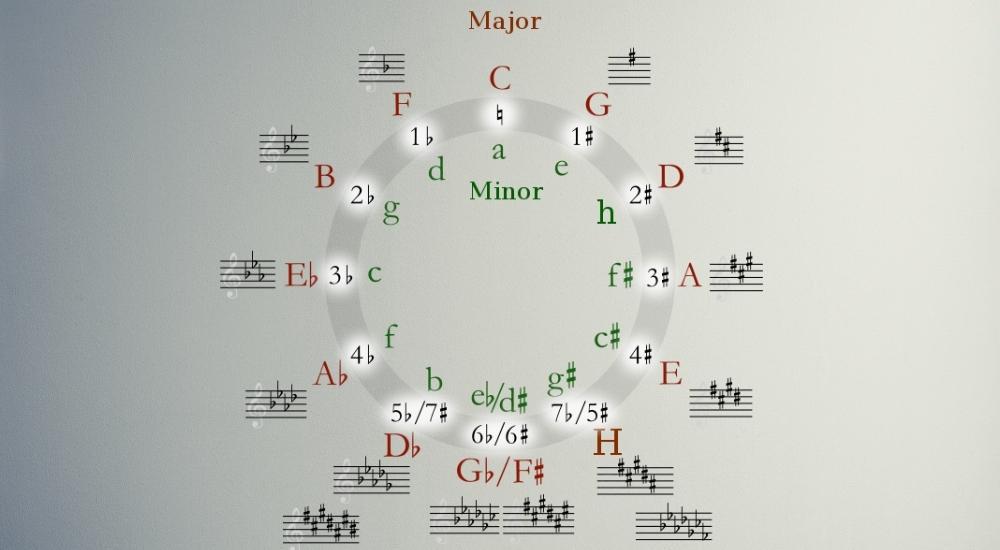
B) How the Clef Can Affect Your Key Signature
The reason this is important is to know how to notate a key signature if you are ever writing a piece of music. The key signature starts on a different line of the staff based on the clef. The clef is the symbol that comes before the key signature and the time signature.
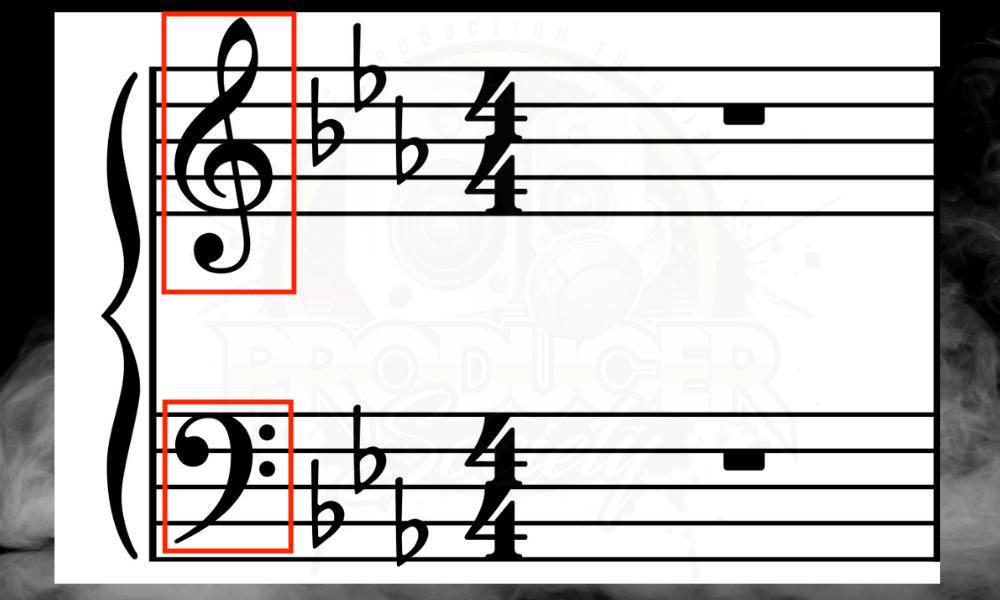
The first flat starts on Bb each time, but the notation is on a different line on the staff. The first sharp starts on F# every time. The clef determines where your first sharp or flat is notated.
For instance, if you’re starting on Bb like what’s shown in the image above, the treble clef has that on the third line from the bottom, whereas on the bass clef, it starts on the 2nd line from the bottom. I should add that there are other clefs too like the alto, tenor, soprano, and mezzo-soprano clefs. But bass and treble are the most common.
What’s The Best Way to Explain A Time Signature?

The best way to explain a time signature is to understand it as a way to divide a certain amount of time and music into an equal number of parts. Simply put, the top number is the number of beats in a measure, and the bottom number is equal to one beat.
Take the top number and tell yourself that, THAT is the number of notes in that measure. Take the bottom number and associate it with the appropriate note length. If it is a 4, that means it’s a quarter note. If it is an 8, that means it’s an eighth note. 16 means it’s a 16th note, and it goes on like that.
For example, in a 4/4 measure, you would take the top number of 4 and know there are 4 notes in that measure. The bottom number tells you those notes are quarter notes. So a 4/4 time signature means there are 4 (top number) quarter notes (bottom number) per measure in the piece of music.
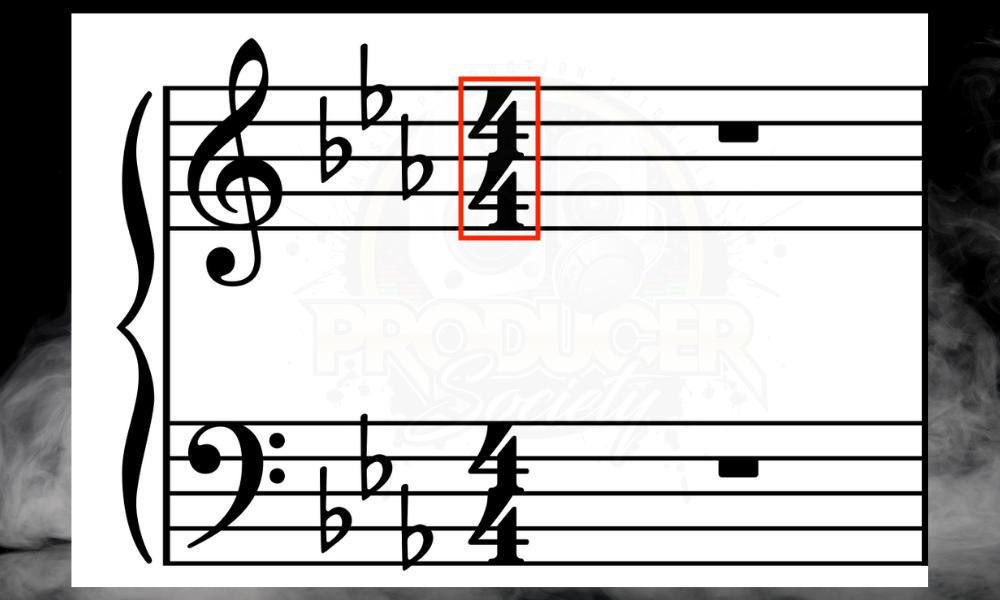
Remember, as long as the measure adds up to or is equal to 4 quarter notes, these note values can be different. So, this means in a 4/4 time signature, there can be 8 eighth notes per measure because 8 eighth notes equal 4 quarter notes.

There are 2 half notes per measure on the bass clef line because 2 half notes equal 4 quarter notes. Keep in mind that a time signature can change in the middle of a song.
What’s the Best Way to Explain A Key Signature?
Simply put, a key signature is a collection of sharps and flats – also called accidentals – that save the composer from having to write accidentals next to the notes over and over again. The key signature also tells you upon which major or minor scale the piece is based.
A key can range anywhere within the 12 keys available in the musical world of possibility, at least in Western terms. Keep in mind that a key signature, like a time signature, can change in the middle of a song.

There are many ways to memorize this kind of thing, including Father Charles Goes Down And Ends Battle, All Cows Eat Grass, and then BEAD-GCF which I did a great job of explaining in detail in my other article on Traveling Guitarist.
Important Things to Note About Key Signatures and Time Signatures
1) There Are Other Ways to Conceptualize And Memorize These Concepts
As the subtitle suggests, there are many ways to conceptualize, understand, and memorize these concepts. I’ve only shown you how I think of them and also how I memorize them.
Go to the Music Theory website to practice some of these concepts, or if you’re really serious about learning, check out the first two resources in the Gear Mentioned section below.

 Written By :
Written By :